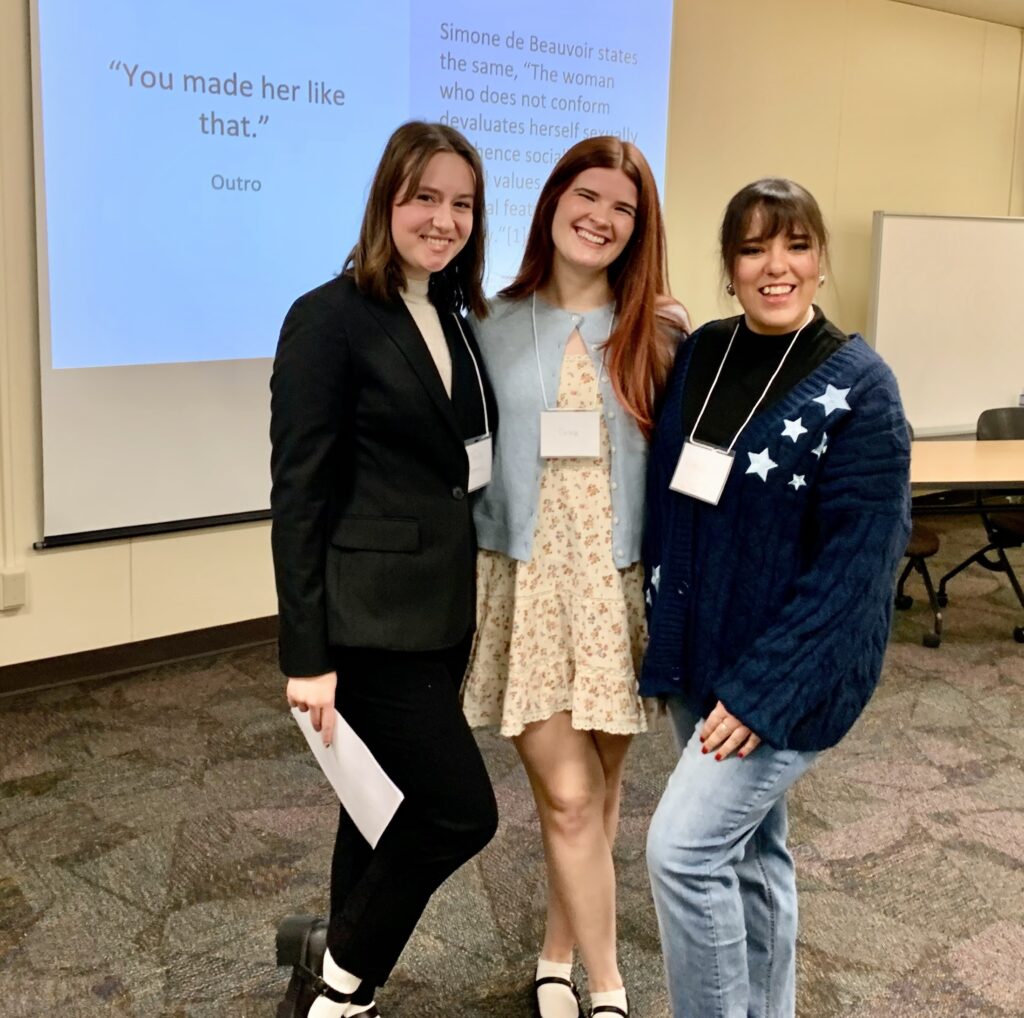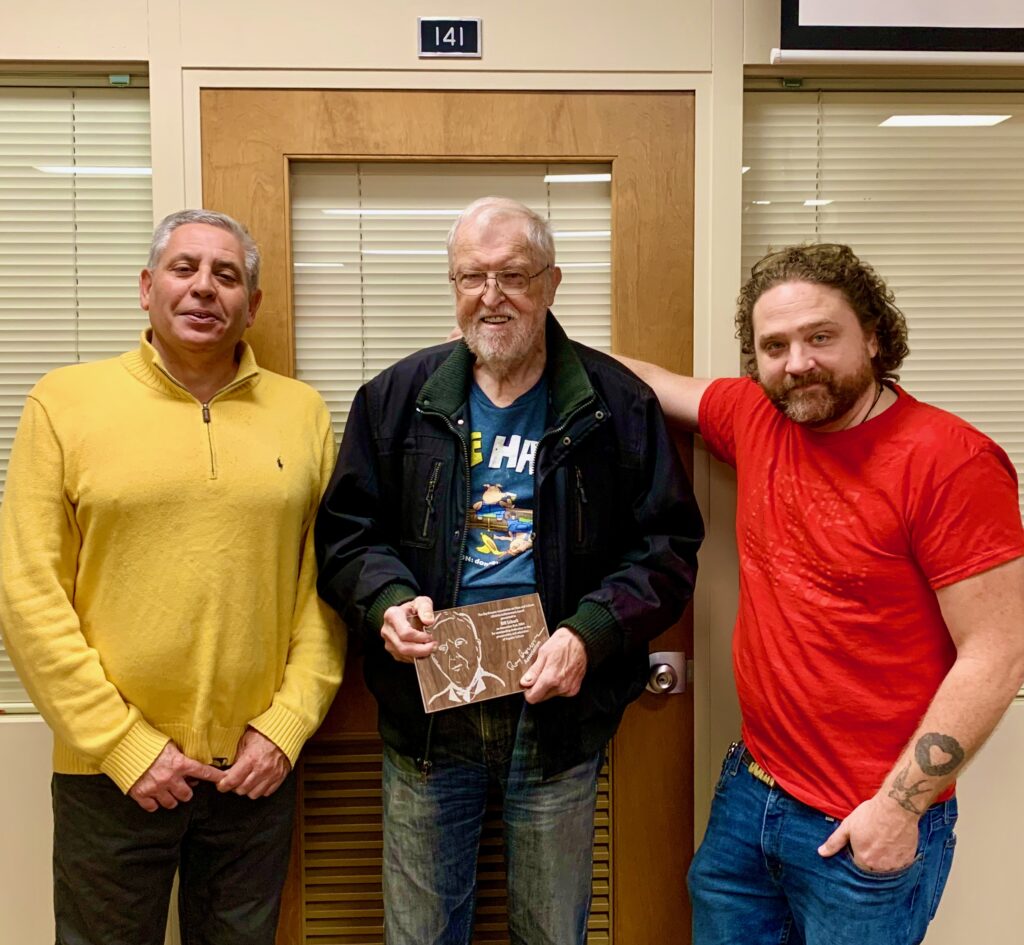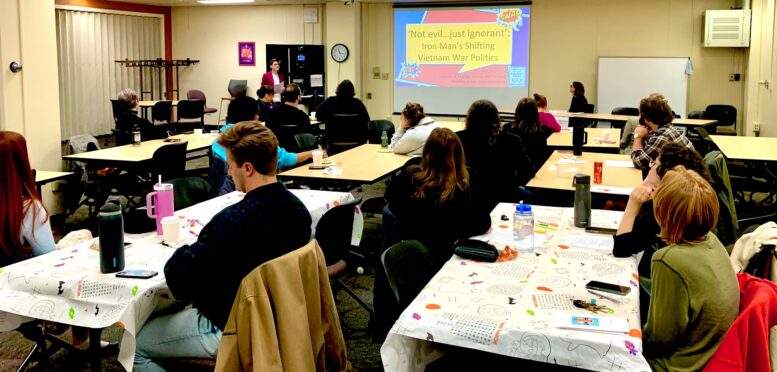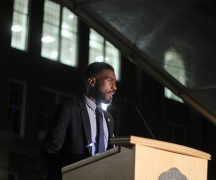By JULIE CARLE
BG Independent News
Three Swifties–an American culture studies doctoral student, a popular culture master’s student and a film studies undergraduate student–stand up in a room and share their research on the American pop culture icon Taylor Swift.
There is no punchline. They just happened to be the first three presenters Saturday at Bowling Green State University’s Ray Browne Conference where popular culture was the sole focus.
Katie Cline, Davis Ritenour and Grace Heerdt talked about Swift’s girlhood aesthetic, the singer-songwriter’s connection to feminism, and how Swift’s “Folklore” album brought comfort, community and love to a population.
Other humanities students brought their conference topics to the forefront, from Sarah Urbank’s “Iron Man’s Shifting Vietnam War Politics” and Caitlin Evans’ “Children of TikTok: Influenced or Influencer?” to Chris Covington’s “Merchandising of Black Characters” and Elizabeth Germann’s “Iterations of Della Street in Perry Mason on CBS and HBO.”
The conference, organized by the graduate students involved in the newly reorganized Ray Browne Association, gives BGSU students the opportunity to present academic papers at a conference–often for the first time.
“It’s how they learn conference comportment. It’s also a lot of fun to learn what research their colleagues are doing,” said Dr. Jeremy Wallach, professor of popular culture and the conference keynote speaker.
“There are so many topics in our field. This reminds us that this is still a very exciting branch of study, and our students continue to do important research,” he said.
The Ray Browne Association on Class and Culture is dedicated to encouraging the study of popular culture as intended by Ray B. Browne, said John King, co-president of the organization. Browne, founder of BGSU’s Department of Popular Culture, paved the way for the organization that gives students a way to bridge the gap between the ivory tower of academy and the lived reality of the BGSU student body and community.
“This is not just one department, but a collaborative effort among the humanities,” said John King, RBA co-president. “The conference demonstrates “the vital work of BGSU humanities students in pop culture, American culture studies, English, theater and film, who demonstrate the value cultural scholars being to the university’s intellectual community and wellbeing.”

Back to the Swifties
Cline, who grew up listening to Taylor Swift, presented what will likely be the first chapter of her doctoral dissertation focusing on Swift’s fandom.
“One thing that this chapter thinks about is ‘Who gets to be a girl under this girlhood aesthetic criteria?’” Cline said. “Anyone who grew up as a tomboy will tell you, not all girls like pink and picnics and friendship bracelets, but this narrow definition of girlhood is also part of a long history of dehumanizing women of color.”
Girlhood’s association with whiteness is nothing new, but there are “damning reverberations in media representation today,” she said, referencing a 2019 study that found Black female characters are more likely to be shown as violent compared to white females and less likely to be portrayed as attractive.
“You can’t be what you can’t see,” Cline told students in her introduction to women’s studies class. “If this is the popular narrative of girlhood, then it sends a very pointed message about who’s included and who’s excluded.”
Her point was “that Taylor Swift, like me, like a lot of us, has white privilege, and that privilege is even more emphasized by this white-coated girlhood resurgence,” she said
In later dissertation chapters, Cline expects to address how Taylor Swift conforms to a cultural idea of white girlhood or white feminism but also how she challenges traditional gender boundaries.
For example, her relationship with Kansas City Chief Travis Kelce has resulted in extreme reactions. Females across the age spectrum have started paying attention to football, while many football fans (predominantly male) have had strong, negative reactions to Swift’s presence at football games.
“These extreme reactions bring back into public consciousness questions of women’s spaces and what happens when women enter traditionally masculine spaces like football fandom and in Swift’s case, she’s bringing her fans with her,” Cline said.
Swift and feminism
During Ritenour’s presentation, “Mad Woman Feminism,” the primary focus was on the intersectionality of Taylor Swift and feminism. The two have “a lot more in common than one would originally think,” she said.
As an international star, Swift holds a lot of sway in fashion, entertainment, and politics. She’s able to accomplish most of this influence through the lyrics and messages of her songs, Ritenour said.
For the basis of her essay, the popular culture master’s student used the song “Mad Woman” from Swift’s eighth album “Folklore,” which is more fictional narrative than autobiographical.
The song provides a narrative of “a woman deemed mad by society,” she said. “Through a feminist analysis, it can be surmised that Taylor Swift is commenting on how society shapes and makes the concept of woman.”
In the song’s lyrics: Does a scorpion strike to kill, you know I will, “Swift obviously doesn’t mean that she’s going to kill, but the woman is using her words to hit her target,” Ritenour said.
Swift’s lyrics underscore the fact that women are not allowed to simply react. They cannot be angry, they can only be overly emotional. If they are angry they are considered as insane or crazy “to really drive home the fact of women only being allowed to have sadness and happiness,” she said
When she sings, Every time you call me crazy, I get more crazy. And when you say I seem angry, I get more angry, Swift is commenting on the irony of the matter and that it is surrounded by the concept of gender.
With this song, her message is clear. “Women are scrutinized for being something society has made them into. Womanhood is a slippery slope where some days women get by and other days women are determined,” Ritenour said.
Swift’s song “may be about a fictitious woman in a fictitious scenario; however, it does not make the story any less true,” she said. “The song makes a common occurring reality come to life to anyone who hears the song either in pieces or in its entirety. One does not have to be a Swifty to get what Swift is trying to tell the world.”
Swift’s music provides ‘safe place in the music world’
For Heerdt, Taylor Swift’s music embodied a place of belonging. The album “Folklore” helped her come to terms with her sexuality and gave her reason to share her story, Heerdt said.
The subtext of Swift’s album initially received criticism for queer baiting, “creating art specifically for queer people that targets our cliques, our views, and our dollars,” she said. “Allyship is creating art where we just naturally fit into the narrative.
The 2020 album “Folklore” finally gets it right, Heerdt said.
Instead of focusing on claims of queer baiting and the intersection with feminism or her capitalistic propensity to make as much profit off the records as possible, “I want to focus on the comfort, community and love this album has brought to me and some other people,” she said. “Listeners can find recurring images, motifs and themes that are often recognized with queerness.”
Heerdt’s favorite song, “Seven” happened to be Swift’s surprise song at her Eras Show Tour in Pennsylvania. The song shares the story of two young girls who share an intimate relationship. To Heerdt, the song illustrates a love so pure and uninhabited by the problems of growing up or from society’s judgment.
“Childhood and the expression of ‘love you to the moon and to Saturn’ express the expansiveness of love between the two people,” she said.
The colors that Swift references in the song signify the colors associated with rainbows and pride. “I feel like this work could be an overarching descriptor of the queer experience for a lot of people, specifically for those who are not as privileged as some to be given a safe space,” she added.
The album, with its ambiguous lyrics, reaches a wide variety of audiences, she said. “Stories like these in the songs bring comfort to listeners.”
Whether or not Swift meant to provide a safe space in the music world, she crafted these stories that speak to listeners and provide them with a home,” Heerdt said. “It’s been a privilege to grow up with Taylor’s music; I owe much of my journey to her.”

Bill Schurk receives Lifetime Achievement Award
At the conference, the RBA presented a Lifetime Achievement Award to Bill Schurk, retired librarian and archivist of the music library and sound recordings archive, which is now named for him.
Schurk, who retired in 2016 after almost 50 years, arrived on campus as popular culture was gaining a leghold in academia. He was hired to head a new audio center in Jerome Library in 1967. He worked with Ray Browne during the time that the center for studying popular culture put BGSU on the map.
Schurk is known for his knowledge of all things music and was key to the music library and sound recordings archive becoming one of the largest collections of popular music at an academic institution in the United States.





